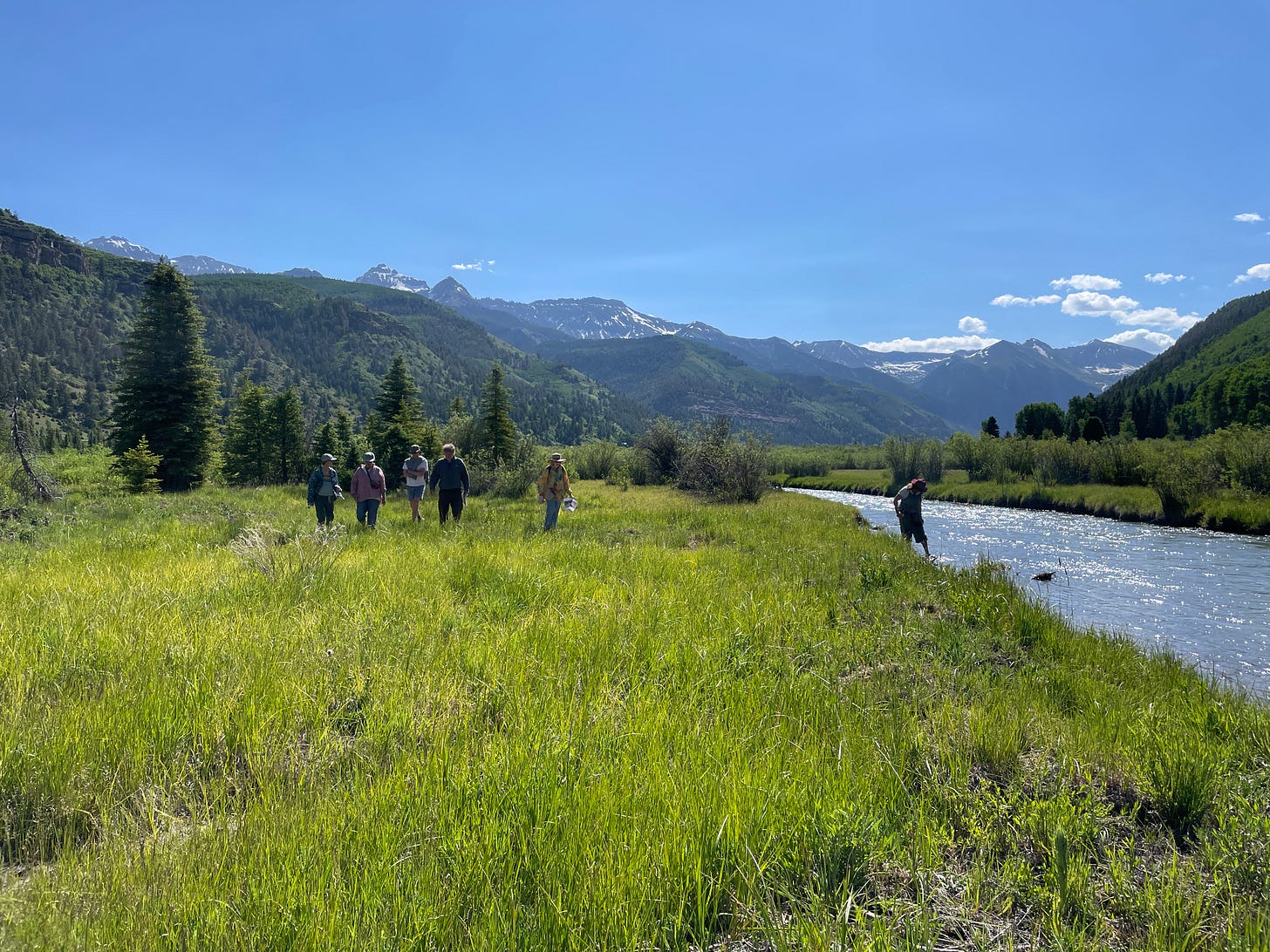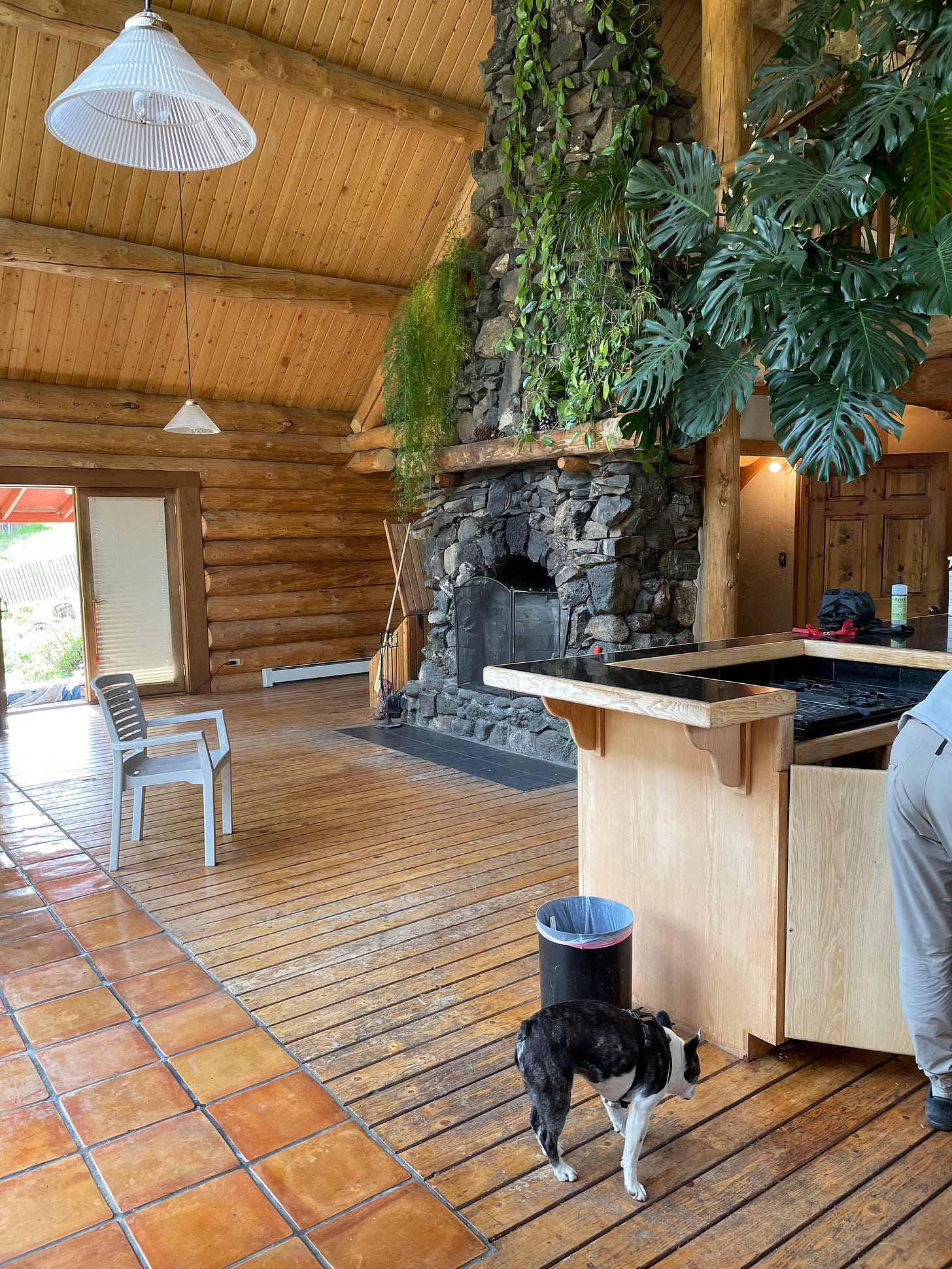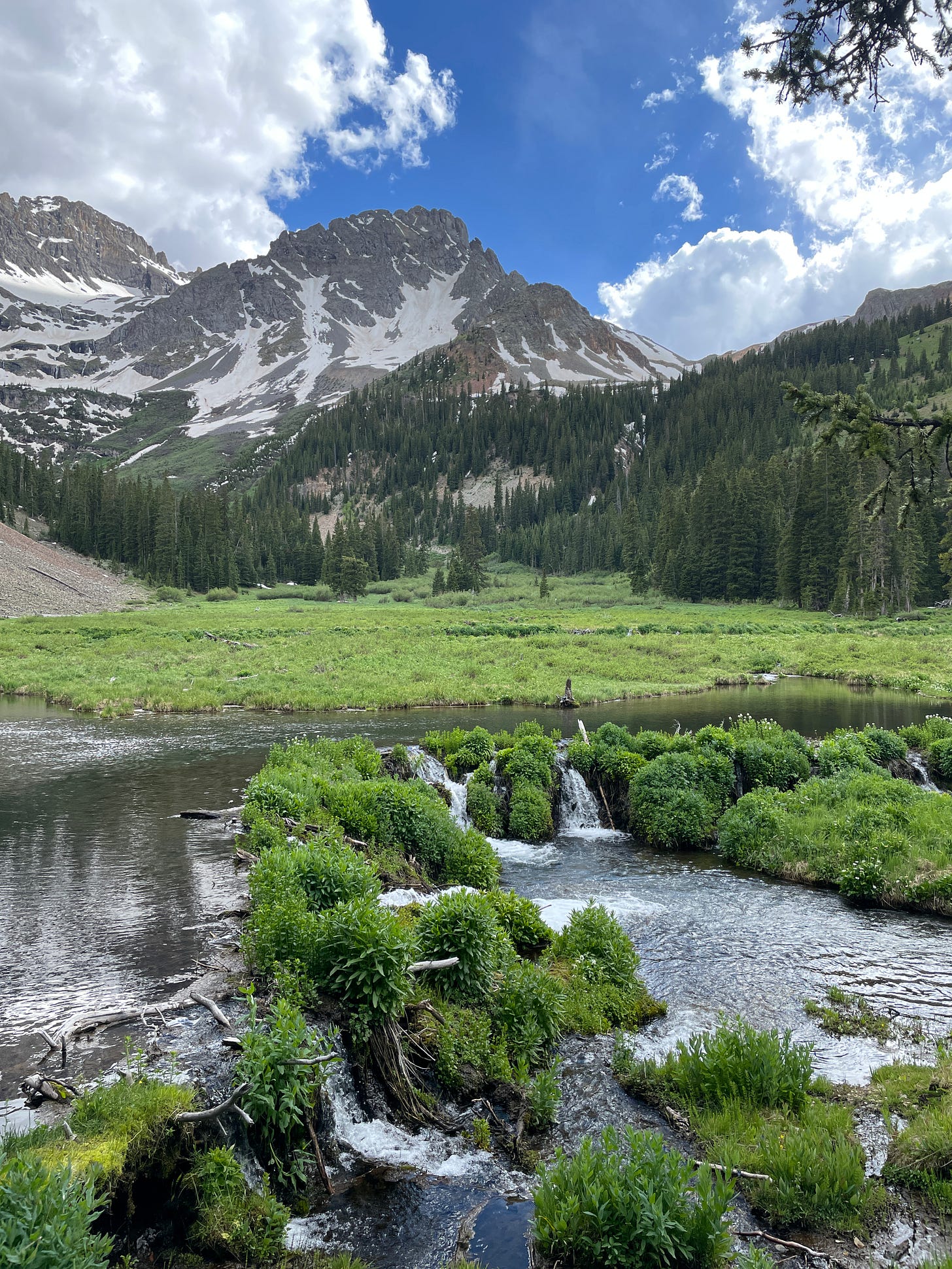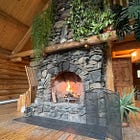Two years ago we caravanned from the Santa Monica Mountains to the Rocky Mountains. Ben drove the 16-foot Penske we’d packed to the brim, and I trailed behind in the Forrester with a cat not nearly high enough on gabapentin. We’d left behind our little treehouse in the canyon for a log cabin in a windy, high alpine valley. We were closing on a home, our home, some five months after we’d first seen it.
Two years ago we were of another place. A place dry and low, of many, many places banded into one by the sea, the mountains, the desert. A place that smelled of palo santo and jacaranda, weed and asphalt, tacos, car exhaust, wildfire, and salt. A place big and all-consuming, dense with people and dreams.
Three days ago, I found myself in some place entirely different. I was standing in the waterlogged ground of a wetland on a walk hosted by the local library to learn about river and wetland restoration. The sun was already over the ridge, promising a sunburn within the hour. The birds shared their plans for the day while a lone elk trotted by to catch up with her herd.
Our herd, meanwhile, looked like an REI outlet of various mountain people: a town manager, a county planner, a forest ecology professor, a ranger, a librarian, and obviously a writer. There were ten of us in various boots, hats, and sunglasses holding stapled presentations like menus. One of the other women there had tattoos in a style similar to mine, and I asked her who she went to. If she liked river walks and tattoo parlors, maybe she’d like me.
Our conversation followed the river, ambling between why we were there, what we did, and where we were from. She “was most recently in Alaska” and I “mostly grew up in Ohio”, words caveated to protect our identities from being too strongly tethered to places we weren’t of. But neither of us had been here long enough to be of here either. She’d only arrived a few months earlier, taking a new role in planning with the county — our county of some 8000 people. I hadn’t been here much longer in the grand plan, but I was resting in the delight of having run into five people I knew all before 10am on the two-year anniversary of living here.
Later that day I wished Ben a happy two year anniversary of buying our house. He said what an arbitrary thing to celebrate, something Ben always says when met with the saccharine. I asked if he wanted to see photos from the day.
“I believe you it was today,” he said.
“That’s not why I’m offering. Sometimes it’s just fun to look.”
He took my phone and scrolled through June and July of 2021: Cooper’s last day at the beach, all our things in boxes, the moving truck, the motel we stayed in the night before moving in, the empty house, the champagne, our first fire, the rainbow, us. He looked up and around at our house.
“We’ve done a really good job,” he said, still holding the phone in his hand. I’d snared him in reverie, and I basked in it as well. Days are always arbitrary until we agree that they’re not.
In two years we’ve sanded the floors, pulled out carpet, built walls, insulated ceilings, built a screen porch, replanted the garden, poured concrete countertops, put up a rock climbing wall, repainted the stairs, painted all the walls, put together a wood shop, tiled a backsplash, chinked the logs, put up a hood vent, replaced (mostly) all the lights, craned in a free hot tub, fixed that hot tub, built a wall around that hot tub, loved that hot tub, hung photos, blinds, and hummingbird feeders, and made this place our own.
As things whirl and shift inside, things cradle and steady outside. Seasons establish rhythms and flowers reappear and trails unveil themselves to spring and summer and autumnal tracks year after year. It is easy to come to a place and believe that is how it was and how it will be and how it should always be. But what’s here is only what’s here now, and as we become of this place, we see how precious — and precarious — it can be.
From expansive mesas to startling peaks, we live in a wildlife mecca and where the wildlife thrive, so too does development. One of the things that drew us to this tiny town when we first came across it in 2019 was its self-imposed development restrictions. On the town plot, there were several areas carved out as designated open space, and not just in places where avalanches slid, but in areas where the lots could now sell for north of $400k. But they’re preserved, both for the beauty and for the town, like gold buried in the backyard. The intention is never really to spend it, but simply to know you have it. This town made clear the only kind of growth they cared about was arboreal.
A town, however, is not a thinking thing. A town doesn’t decide to leave space open — its residents do. On Tuesday night, the town held its monthly general assembly meeting, and one of those residents wanted to remind us of what it took to preserve that space.
After the mining heyday of this town, the population bottomed out at one person. By the 1970s, only six people lived here. The 1990 census recorded 69 people and it was those people who saw the town resurrecting. It was becoming easier to live somewhere difficult, and it was also becoming more appealing. To keep this valley wild, the town and its people needed to take action.
It started with the town’s Open Space Program in 1992 — the beginning of a multi-decade effort to protect this environment and promote “stewardship of these properties in their original state, including vistas and vegetation, or to restore them to a more native state.” This town was nestled in the middle of 1200+ acres of undeveloped mining claims within the greater national forest, and it sat quietly after the mining boon until the owners of two of the larger claims were interested in developing.
The Open Space Program established that town-owned buildable lots could be used as a land bank to fund future open space purchases, including those mining claims in the upper bowls and canyons. The town moved quickly to acquire the claims through purchase and land swaps, but positioned themselves for a game of whack-a-mole if they didn’t find support.
It took the support of landowners, town residents, the Forest Service, local and regional government, the local conversation foundation, and the Trust for Public Land (TPL) national non-profit to purchase and transfer all 1,200 acres with over 100 privately owned claims to national forest. This effort spanned from the early 90s until 2010 when the land was brokered to the US Forest Service.
It wasn’t until 2018 that even further protections were put in place. A new wilderness act designated anything over 21,000 acres as protected, noting that anything in a “high country area” could not see road development. High Country Area is anything over 10,000 feet, thus protecting the entire alpine ecosystem around the town.
When we first found this place on a map, one of the things we loved about it was the backcountry access, the town spring water, the unmarked trail system. You could live here and never second guess those things. You could see the old mining roads and assume the trails were left, the claims abandoned, the national forest always there. But it took decades of community organization to ensure this land was accessible to the public and preserved for the wild.
Standing in the marsh in the town over, you could let yourself make the same assumptions. It was a marsh that had always been a marsh and there were no houses because you couldn’t build on it. It’s always been the home to elk and badgers, prairie dogs and otters, beavers and mountain lions. But you would be wrong.
The 500 acres we were standing on, a glacial valley flanked by peaks on one end and moraines on the other, were slotted for hotels, golf courses, and gondolas. In a multi-decade legal battle with developers, the state, and others that went all the way to the Colorado Supreme Court, the town fought tooth and nail to protect this ecosystem. They successfully raised $25,000,000 in private donations, paid a total of $50 million for the land, and were granted the right of eminent domain to home rule municipalities allowing them to condemn the land and prevent all future development without the town’s consent.
That happened in 2008, and the town threw a party. I was in the British Virgin Islands, probably also at a party, but in a moment that changed the history of this place, I was of another one.
In 2023, there are plaques along the few trails that run through here. It wasn’t until 2015 that the river restoration project would even begin. The marsh I was standing in had been a tailings field, piles of toxic mining sediment that poison the ground. Tons of it had been dumped where I was standing. The EPA’s multi-million dollar plan was to simply cap the tailings with a flat top soil, revegetate with grass, and leave it, thus also leaving it unnatural and unscenic.
The town proposed something else, for the same fee, and created what is now a growing ecological wonderland for native species. Some tailings were removed, some consolidated, and the entire river was rerouted to create a flowing and hospitable environment that no longer swathed with gravel. Standing in the marsh, you would have needed intimate knowledge of glacial fields and river paths, soil and flora to ever know something had changed. You would also have needed a history lesson, a legal background, or a local to know things could have been much worse. Spruce and willow scattered the rolling field, flowers bloomed and animals vanished between grasses, and a few humans stood around with printouts to understand an evolving ecosystem that took thousands of humans and millions of dollars to protect.
We’ve lived here for two years, but two years isn’t long enough to be of a place. It’s not long enough to see how things change and what it means when they don’t. When our neighbor stood in the town assembly to tell us how our open space came to be, it wasn’t just a history lesson. It was a tutorial. In capitalism, the only place for otters is the zoo and the only place for elk is the table. When there is something worth protecting, something that can’t protect itself, someone will always try to protect it. But it only works when that someone is us.









Another great piece! Love this exploration of the far-reaching, generative impact that invested, active citizens can have in their communities. Thanks for launching this hopeful, helpful reminder into the universe after a rough week of set backs in the U.S.
That's all wonderful and those photos are spectacular. Coming to Colorado next month and excited to be in the mountains again!